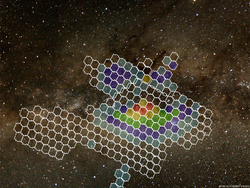- Optical Gravitational Lensing Experiment
-
 OGLE telescope at the Las Campanas Observatory
OGLE telescope at the Las Campanas Observatory
 Artist's impression of the planet OGLE-2005-BLG-390Lb discovered by the OGLE Team
Artist's impression of the planet OGLE-2005-BLG-390Lb discovered by the OGLE Team
 OGLE-IV Galactic Bulge fields with cadence, from OGLE-IV sky coverage.
OGLE-IV Galactic Bulge fields with cadence, from OGLE-IV sky coverage.
The Optical Gravitational Lensing Experiment or OGLE is a Polish astronomical project based at the University of Warsaw that is chiefly concerned with discovering dark matter using the microlensing technique. Since the project began in 1992, it has discovered several extrasolar planets as a side benefit. The project is led by Professor Andrzej Udalski, who is a co-author of the discovery of OGLE-2005-BLG-390Lb.
The main targets of the experiment are the Magellanic Clouds and the Galactic Bulge, because of the large number of intervening stars that can be used for microlensing during a stellar transit. Most of the observations have been taken at the Las Campanas Observatory in Chile. Cooperating institutions include Princeton University and the Carnegie Institution.
The three phases of the project had already been concluded, OGLE-I (1992–1995), OGLE-II (1996–2000), and OGLE-III (2001–2009). OGLE-I was the project pilot phase; for OGLE-II, a telescope was specially constructed, placed in Las Campanas Observatory and dedicated to the project. The 8-chip mosaic CCD camera was built in Poland and shipped to Chile. OGLE-III was primarily devoted to detecting gravitational microlensing events and transiting planets. As a byproduct of constant monitoring of hundreds of millions of stars, the largest catalogs of variable stars were constructed. The fields in four main directions where monitored during this phase: in the direction of the Galactic Bulge, the constellation Carina [1] and toward both Large Magellanic Cloud and Small Magellanic Cloud. Also, first planets using the microlensing technique were detected during that phase. In 2010, following engineering work in 2009, the fourth phase, OGLE-IV, have been started using 32-chip mosaic CCD camera. The main goal for that phase is to increase the number of planetary detections using microlensing. The increased field of view of the new camera give the possibility for increased cadence of observations when keeping the monitored area of the sky at similar level.
Contents
Planets discovered
Fourteen planets have so far been discovered by the OGLE project. Eight of the planets were discovered by the transit method and six by the gravitational microlensing method.
Planets are shown in the order of discovery. Planets in multiple-planet systems are highlighted in yellow. Inclinations with + means orbit has at least that inclination.
Star Constellation Right
ascensionDeclination App.
mag.Distance (ly) Spectral
typePlanet Mass
(MJ)Radius
(RJ)Orbital
period
(d)Semi-major
axis
(AU)Orbital
eccentricityInclination
(°)Discovery
yearOGLE-TR-10 Sagittarius 17h 51m 28s −29° 52′ 34″ 15.78 5000 G2V OGLE-TR-10 b 0.63 1.26 3.10129 0.04162 0 84.5 2002 OGLE-TR-111 Carina 10h 53m 01s −61° 24′ 20″ 16.96 5000 G OGLE-TR-111 b 0.53 1.0 4.01610 0.047 0 88.1 2002 OGLE-TR-132 Carina 10h 50m 34s −61° 57′ 25″ 15.72 7110 F OGLE-TR-132 b 1.14 1.18 1.689868 0.0306 0 85 2003 OGLE-TR-56 Sagittarius 17h 56m 35s −29° 32′ 21″ 16.56 4892 G OGLE-TR-56 b 1.29 1.30 1.211909 0.0225 0 78.8 2003 OGLE-TR-113 Carina 10h 52m 24s −61° 26′ 48″ 16.08 1800 K OGLE-TR-113 b 1.32 1.09 1.4324757 0.0229 0 89.4 2004 OGLE-2003-BLG-235L
/MOA-2003-BLG-53LSagittarius 18h 05m 16s −28° 53′ 42″ 19000 K OGLE-2003-BLG-235Lb 2.6 4.3 2004 OGLE-2005-BLG-071L Scorpius 17h 50m 09s −34° 40′ 23″ 19.5 9500 M OGLE-2005-BLG-071Lb 3.5 3600 3.6 2005 OGLE-2005-BLG-169L Sagittarius 18h 06m 05s –30° 43′ 57″ 19.4 8800 M? OGLE-2005-BLG-169Lb 0.041 0.345 2006 OGLE-2005-BLG-390L Sagittarius 17h 54m 19s -30° 22′ 38″ 21500 M? OGLE-2005-BLG-390Lb 0.018 2006 OGLE-TR-211 Carina 10h 40m 15s −62° 27′ 20″ 5300 F OGLE-TR-211 b 1.03 1.36 3.67724 0.051 0 87.2+ 2007 OGLE-TR-182 Carina 11h 09m 19s −61° 05′ 43″ 16.84 12700 G OGLE-TR-182 b 1.01 1.13 3.9791 0.051 0 85.7 2007 OGLE2-TR-L9 Carina 11h 07m 55s −61° 08′ 46″ 2935 F3 OGLE2-TR-L9 b 4.5 1.61 2.4855335 0.0308 2008 OGLE-2006-BLG-109L Sagittarius 17h 52m 35s −30° 05′ 16″ 4900 OGLE-2006-BLG-109Lb 0.71 1825 2.3 2008 OGLE-2006-BLG-109L Sagittarius 17h 52m 35s −30° 05′ 16″ 4900 OGLE-2006-BLG-109Lc 0.27 5100 4.8 0.11 59 2008 Note. For events detected by the gravitational microlensing method, year stands for OGLE season, BLG means that an event detected is in the Galactic BuLGe, and the following 3-digit number is an ordinal number of microlensing event in that season. For events detected by the transit method TR stands for TRansit and the following 3-digit number is an ordinal number of transit event.
See also
- Bohdan Paczyński
- All Sky Automated Survey
- Grzegorz Pojmański
- Microlensing Observations in Astrophysics (MOA)
- List of planetary systems
References
- ^ Udalski et al. "The Optical Gravitational Lensing Experiment. Real Time Data Analysis Systems in the OGLE-III Survey". Acta Astronomica 53: 291–305. http://acta.astrouw.edu.pl/Vol53/n4/pap_53_4_1.pdf.
External links
- OGLE Homepage in Warsaw, Poland
- OGLE-IV sky coverage: OGLE-IV fields
Categories:- Astronomical surveys
- Experiments for dark matter search
- Gravitational lensing
- Telescopes
- Exoplanetology
Wikimedia Foundation. 2010.
